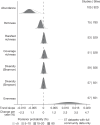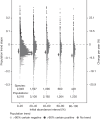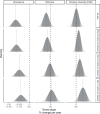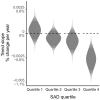Disproportionate declines of formerly abundant species underlie insect loss
- PMID: 38123681
- PMCID: PMC11006610
- DOI: 10.1038/s41586-023-06861-4
Disproportionate declines of formerly abundant species underlie insect loss
Abstract
Studies have reported widespread declines in terrestrial insect abundances in recent years1-4, but trends in other biodiversity metrics are less clear-cut5-7. Here we examined long-term trends in 923 terrestrial insect assemblages monitored in 106 studies, and found concomitant declines in abundance and species richness. For studies that were resolved to species level (551 sites in 57 studies), we observed a decline in the number of initially abundant species through time, but not in the number of very rare species. At the population level, we found that species that were most abundant at the start of the time series showed the strongest average declines (corrected for regression-to-the-mean effects). Rarer species were, on average, also declining, but these were offset by increases of other species. Our results suggest that the observed decreases in total insect abundance2 can mostly be explained by widespread declines of formerly abundant species. This counters the common narrative that biodiversity loss is mostly characterized by declines of rare species8,9. Although our results suggest that fundamental changes are occurring in insect assemblages, it is important to recognize that they represent only trends from those locations for which sufficient long-term data are available. Nevertheless, given the importance of abundant species in ecosystems10, their general declines are likely to have broad repercussions for food webs and ecosystem functioning.
© 2023. The Author(s).
Conflict of interest statement
The authors declare that they have no competing interests.
Figures













References
MeSH terms
LinkOut - more resources
Full Text Sources

